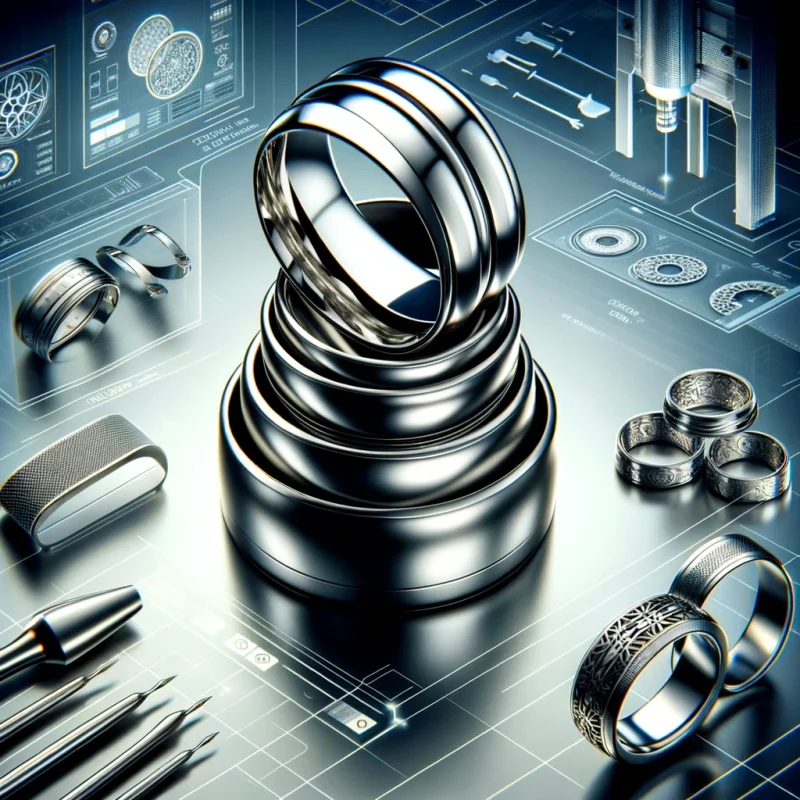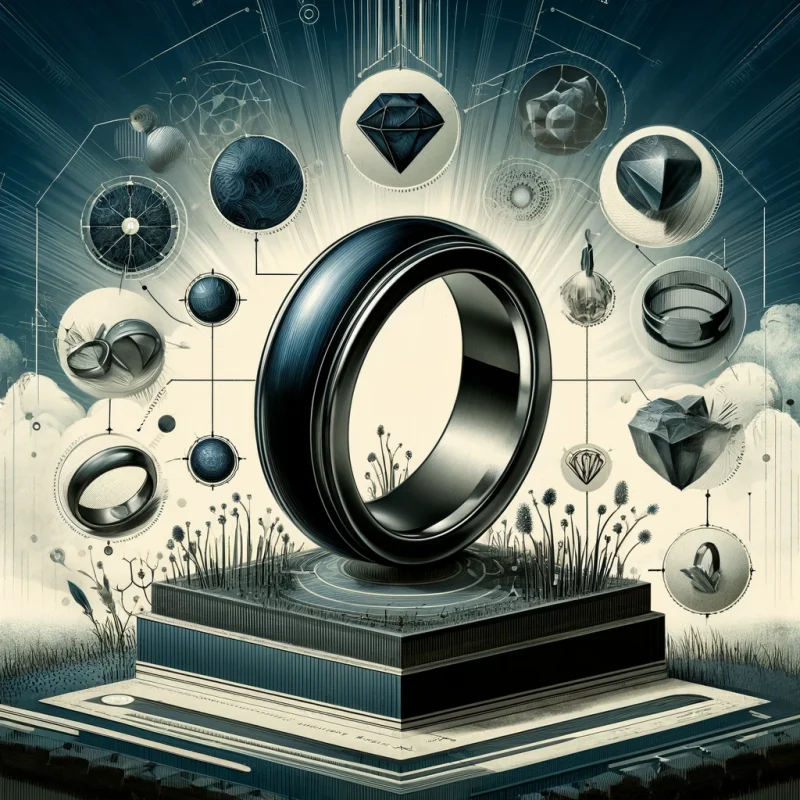Being in the jewelry business myself, I know how crucial craftsmanship is for titanium rings. Each ring is made of Titanium for its unmatched strength-to-weight ratio and corrosion resistance, which goes through a rigorous manufacturing process to ensure that they last.
The Reasons Behind Titanium’s Excellent Properties
Enter Titanium, which of course is already well known for its inherent strength and low density as well as biocompatibility — a must-have feature when dealing with jewelry that is worn daily. It is corrosion resistant hence titanium rings do not tarnish even after frequent water and chemical contact.
The Selection and Preparation of Materials
This journey starts with the highest purity titanium alloys, practically always Grade 2 (pure) Titanium as it is softer and easier to manufacture into jewelry. Quality is achieved by sourcing these alloys from certified suppliers. There is a strong emphasis on purity and strength as the titanium has to pass through ASTM (American Society for Testing and Materials) certification.
Casting and Machining
After confirmation of the titanium alloy, it is time for precision machining. Along comes the step, your raw material is now used in highly advanced CNC (Computer Numerical Control) machines to cut and shape the bar stock into that ring profile you so generously designed. A CNC machine can produce intricate or simple lines with extreme precision, down to a micrometer-level tolerance.
Increases Strength With Heat Treatment
Critical annealingAfter the shaping, The titanium rings will be critical annealing. This process includes heating the rings to temperatures that are higher or lower, followed by a rapid quenching and more so gradual cooling of the material to enhance its mechanical properties. This heat treatment strengthens the titanium, thus enabling it to withstand everyday wear and tear without deforming or losing its form.
Study of Surface Finishing and Polishing
Then come the final touches after cooling into shape. These artisans hand polish those surfaces to a mirror-like degree of finish or apply specialized treatments including the black titanium coating. This finish not only enhances the look of the ring but makes it more scratch-resistant and tarnish-free.
Quality Assurance and Testing
Each titanium ring must pass thorough quality control before it leaves our workshop. Such performance tests include measurements for dimensional accuracy, visual quality control inspections to ensure that the part does not contain any flaws or blemishes, and strength testing under simulated usage conditions. All rings are produced by ISO (International Organization for Standardization) guidelines to guarantee the industry standards of each manufacturer.
Innovation and Future Trends
Thoughts to the future — current titanium ring developments are based on sustainability and tailor-made. Instruments such as 3D printing (additive manufacturing) are gradually getting included, providing for complex structures with a decrease in material wastage. Available with custom engraving, inlaid gems, and several other options this ring caters to many different consumer preferences while still maintaining the strength of titanium.
Tech-Forward Factories — Advanced Manufacturing Techniques
Manufacture methods with titanium rings are highly innovative. New techniques such as laser cutting and 3D printing are changing the way that titanium is applied in making jewelry, but it still aligns itself closely with the technology used for CNC machining. This technology enables highly complex designs and individual components for a wide variety of customer requirements.
Tailoring Your Experience
The making of titanium rings is that it can bend itself to customization. From engraving initials and birthstones to designing a unique one of its own, the manufacturer uses Computer-Aided Design (CAD) software. It not only makes the jewelry more aesthetically pleasing but also increases its sentimental value for the wearer.
Environmental Sustainability
Despite being durable, Titanium also boasts environmentally friendly credentials. From sustainable sourcing of raw materials to minimal waste and energy use, the entire production cycle is made by manufacturers. Therefore, titanium ring makers are even more environmentally friendly as a result of their conscientious nature concerning the planet.
QC & CertificationPVDF fluoro resin is produced in an integrated quality control system based on ISO 9001 standards.
Silicone rings Everything Titanium ring manufacturing is performed with the highest standards in mind. Strict quality control procedures are carried out to check the strength, purity, and corrosion resistance nature of these SS 347H Plates. To accept industry standards, rings undergo intensive testing to ensure adherence and superior reliability over a lifetime.
Consumer Preferences and Industry Trends
For manufacturers, staying ahead of the curve is a must. And all this, by incorporating into it the touch of present timekeeping while retaining its tasteful timeless charm. As consumer preferences are influenced by the trends of minimalist, mixed-metal aesthetics, and sustainability in jewelry so is the face-lift of tungsten wedding ring styles.
Expert Design/Engineering
The lifecycle of a titanium ring starts with fresh design approaches where the flow between creative finesse and engineering accuracy is woven together. This allows our talented designers the ability to create intricate patterns and shapes for each ring, all while making certain that both are aesthetically beautiful as well as structurally sound with supported CAD software. That first phase lays the groundwork for transforming concepts into objects of wearable art.
Metallurgical Expertise
Metallurgical science in the selection and refining of titanium alloys is extremely important. Depending on what they are trying to achieve grade 2 or grade 5 titanium is selected, among other varieties; this can be in terms of physical strength qualities, heightened toughness, and also corrosion resistance. These alloys undergo several alloying and refining steps before being processed into rings.
Precision Casting and Forging
Titanium rings are usually either cast or forged, depending on the design complexity. Casting — Molten titanium is poured into molds to create complex forms with details. A physically different process to milling is forging, which involves touch and temperature controls that transform solid titanium into the appropriate shapes. The consistent quality and structural integrity essential for long-term longevity, are the outcome of both techniques.
Surface Treatment & Finish
Titanium Rings are surface-treated for an appealing aesthetic and long-lasting strength. The result ranges from high luster to matte, depending on the texture and type of finish required using several techniques ranging from polishing or brushing up to sandblasting. Certain rings are anodized, which applies a color and increases scratch resistance. The added finishing digits look beautiful, but it is also protecting against everyday wear.
Quality Control and Certification
Getting a titanium ring may go through multiple steps of quality check to make sure its strength and durability measure up to the rest in the industry. The testing aspects may incorporate measurement of dimensional accuracy, performing stress tests, and assessing resistance to environmental factors such as moisture or temperature variations. These certifications from reputed bodies ensure the authenticity and quality of the ring.
Consumer Literacy & Sustainable Practices
Helping inform consumers of the advantages, like titanium being hypoallergenic and environmentally sound is key to its appeal. Its low weight moves less carbon during transport and its durability minimizes the need for replacement, meeting consumer trends of sustainability.
Conclusion
To that end, learning how titanium rings are made underscores their desirability as long-lasting and stylish pieces of jewelry while also being good for the environment. From the design concept to the final finishes every step in the manufacturing process speaks of commitment, craftsmanship along novelty. Personal Style or Emotional Value – Titanium Rings are Timeless and Durable.


